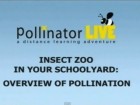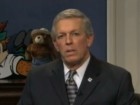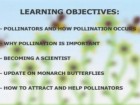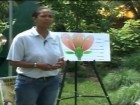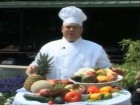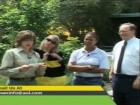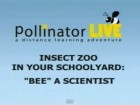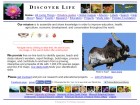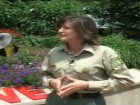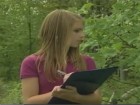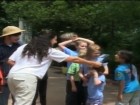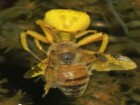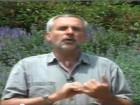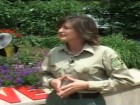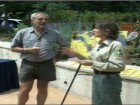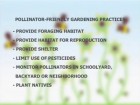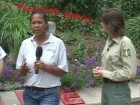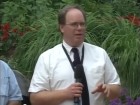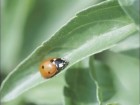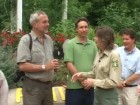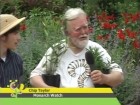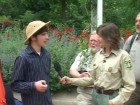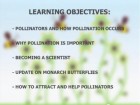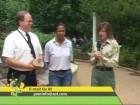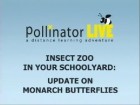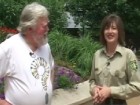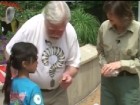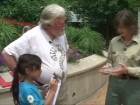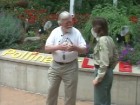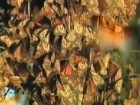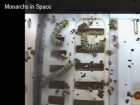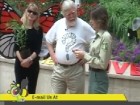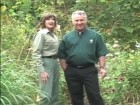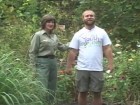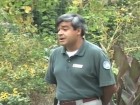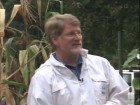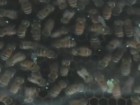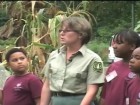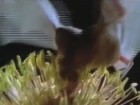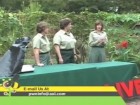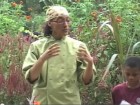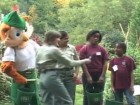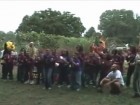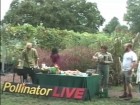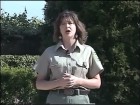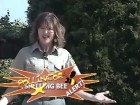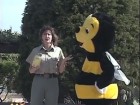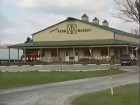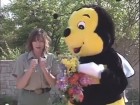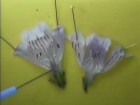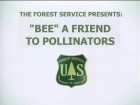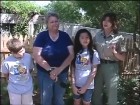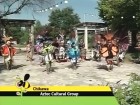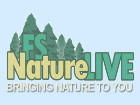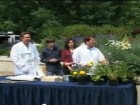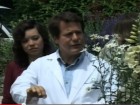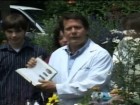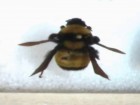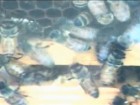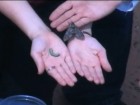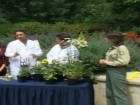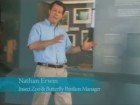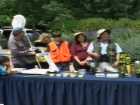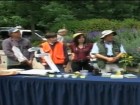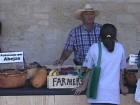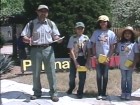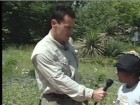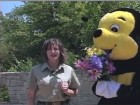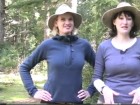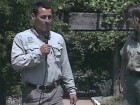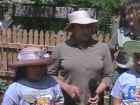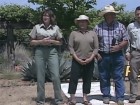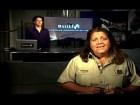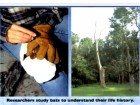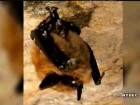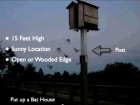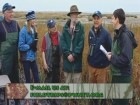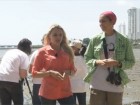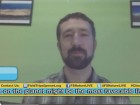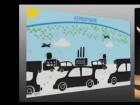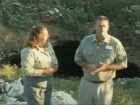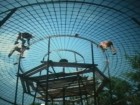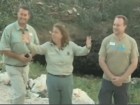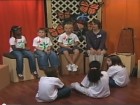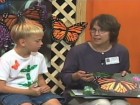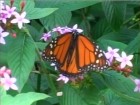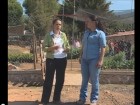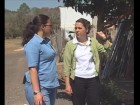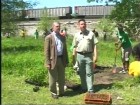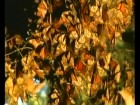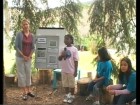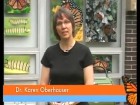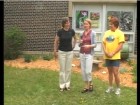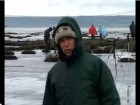Home>Video
Video
Reduce Pesticide Use
Sean Brady with the Smithsonian Natural History Museum talks about the importance of limiting pesticide use.
Segment
Program:
PollinatorLIVE: The Insect Zoo in Your Schoolyard: Attracting Pollinators to Your Schoolyard Garden
Original Air Date:
Sep 15, 2014
Web Site:
http://pollinatorlive.pwnet.org/
Insect Zoo in Your Schoolyard: Overview of Pollination
USDA Forest Service host Tamberly Conway introduces the webcast, “The Insect Z...
Welcome from USDA Forest Service Associate Chief
USDA Forest Service Associate Chief Hank Kashdan talks about the importance of p...
Learning objectives for the program
During the program, learn about pollinators, how pollination works, how to becom...
Electronic field trip technology
Electronic field trips enable you to take a distance learning adventure through ...
Overview of Pollination and Pollinators
Learn how plants are pollinated and how animals and insects help with that impor...
Questions and Answers from "Overview of Pollination"
Experts answer questions about pollination, what would happen if food plants are...
Insect Zoo in Your Schoolyard: “Bee a Scientist”
Dr. John Pickering, an ecology professor at the University of Georgia, talks abo...
Discover Life Web Site
Dr. Pickering explains the purpose of Discover Life and how to be a citizen scie...
How to Participate in Discover Life
This roll-in explains how to participate in Discover Life. ...
Discover Life Helps Catalog Insects
Discover Life catalogs and maps the locations of insects and other species....
Questions and Answers
Dr. Pickering discusses different types of bees, how to safely studying bees, ho...
Insect Zoo in Your Schoolyard: Attracting Pollinators to Your Schoolyard Garden
USDA Forest Service host Tamberly Conway discusses how to help pollinators....
Providing Habitat for Pollinators
Alan Peters with the Smithsonian National Zoo talks about how to provide habitat...
Providing Solitary Bees with Bee Boxes
Nate Erwin with the Smithsonian Natural History Museum talks about bee boxes....
Reduce Pesticide Use
Sean Brady with the Smithsonian Natural History Museum talks about the importanc...
Monitoring Pollinators
Dr. John Pickering with Discover Life stresses that it is important and interest...
Using Native Plants in the Garden
Dr. Chip Taylor, Executive Director of Monarch Watch, emphasizes how important i...
Summary of PollinatorLIVE Webcasts
USDA Forest Service host Tamberly Conway sums up the PollinatorLIVE webcasts....
Questions and Answers
Experts answer questions about pollinators, gardening, monarch butterflies, bees...
Insect Zoo in Your Schoolyard: Monarch Update
Dr. Chip Taylor, director of Monarch Watch, provides an update on the status of ...
Tagging Monarchs for Research
Dr. Chip Taylor, director of Monarch Watch, discusses the research results from ...
How to Tag Monarch Butterflies
Dr. Chip Taylor, director of Monarch Watch, explains how to tag a monarch butter...
How Butterflies and Bees See
Dr. Chip Taylor, director of Monarch Watch, explains how butterflies and bees se...
Monarch Migration
Dr. Chip Taylor, director of Monarch Watch, talks about monarch migration. ...
How to Help Monarchs
Dr. Chip Taylor, director of Monarch Watch, talks about threats to monarchs and ...
Monarchs in Space
Dr. Chip Taylor, director of Monarch Watch, talks about an experiment in which m...
Questions and Answers about Monarchs
Dr. Chip Taylor, director of Monarch Watch, answers questions about monarchs....
Introduction to Washington Youth Garden
Program director Kaifa Anderson Hall introduces the Washington Youth Garden....
Bees, Gardening and More: Native and Honey Bees
Naturalist Alonso Abugattas talks about native bees and their importance to poll...
Bees, Gardening and More: Bats, Butterflies and Other Insect Pollinators
USDA Forest Service entomologist and students go on an insect hunt....
Bees, Gardening and More: Pollinator Kitchen and Café
Top Chef Carla Hall cooks with foods developed as the result of pollination. ...
Introduction to Nature's Partners: Pollinators, Plants and People
The PollinatorLIVE electronic field trip was held at the Lady Bird Johnson Wildf...
Pollinator Bee
During the PollinatorLIVE program, students played a game and answered questions...
Plants and pollinators are partners
Native plants provide food for pollinators and other wildlife....
“Bee” a friend to pollinators
People can help pollinators by using pollinator-friendly practices....
How to help pollinators
People can help pollinators by planting native plants, providing habitat, partic...
Chikawa performs butterfly dance
The Aztec cultural group Chikawa performs a butterfly dance....
Insect Zoo in Your Schoolyard: Pollinator Partners
Sean Brady and Nate Erwin from the Smithsonian’s Natural History Museum and In...
Pollinator Partners
Plants depend on insects for pollination and are partners in this process....
Bee collection and honey bees
Bee collections help scientists and other study bees. A live honey bee hive is s...
Tour of the Smithsonian’s insect collection
Tour of the Smithsonian’s honey bee hive and insect collection and learn about...
Questions and answers about pollinator partners
Scientists answer questions about pollinators, insects, butterflies and more....
VĂdeo Bug Chicks – MisiĂłn de PolinizaciĂłn
Las “Bug Chicks” hablará sobre la importancia de los pollinzadores ...
Mercado de Agricultores
Dos estudiantes visitan un mercado de agricultores y aprenden sobre la importanc...
Primer Grupo de Cientificos Estudiantes
Ramiro Villalvazo, Supervisor Forestal del Servicio Forestal Del Departamento de...
Tercer Grupo de CientĂficos Estudiantes – Jardin de Colores
Eddie McKenna y el tercer grupo de cientificos estudiantes observaran dos camas ...
VĂdeo Bug Chicks – Plantas y Polinizadores son IncreĂbles Socios
Bug Chicks - “Las Chicas de los Insectos” nos ayuden a explicar cómo las p...
Observar y Anotar Datos con Ramiro
El equipo de cientĂficos estudiantes, fueron de excursiĂłn con Ramiro a observa...
Observar y Anotar Datos con Eddie
El equipo de cientĂficos estudiantes, fueron de excursiĂłn con Eddie y hablan s...
Ayudando a los Polinizadores, Ser Amigos de los Polinizadores
Las especies están disminuyendo, la Abejita de la Seguridad está llorando. Vea...
CientĂfico Ciudadano
Tamberly habla sobre lo mucho que se puede hacer para los polinizadores como con...
Importance of Bats
Bats are important because they eat insects, spread seeds, pollinate flowers, an...
Researchers study bats
Researchers study bats to learn about their life history and to protect bats....
White-Nose Syndrome is killing bats
White-Nose Syndrome is a new disease that has killed millions of bats....
How to help bats
Many activities can help bats such as recycling, buying locally grown food,
pro...
Migratory birds
A healthy string of wetlands is important for migratory shorebirds that rely on ...
Ice Cores Provide Evidence of Climate Warming
Ice cores have provided key information about how we know that climate has chang...
Why should we care about climate change?
The Earth and its species are perfectly adapted to the climate and climate chang...
Causes of climate change
The Earth is warming mainly because people are burning more fossil fuels for ene...
Green Ambassadors work on climate solutions
Green Ambassadors work at the school and in the community to reduce their ecolog...
Reduce use of plastic bottles
Plastic bottles are wasteful because tap water supplies are safe, water bottles ...
Dreaming in Green
Students focus on energy use at their school and were able to save thousands of ...
Alternatives to fossil fuels
There won’t be one change that enables us to reduce the use of fossil fuels, b...
Close of program
There are many actions that students can take to reduce energy consumption and t...
Carbon Dioxide Increasing in the Atmosphere
More carbon dioxide in the atmosphere is contributing to climate change....
Bat echolocation
Jim Kennedy with Bat Conservation International talks about echolocation and dem...
David Bamberger’s artificial bat cave
Bat houses provide habitat for bats and David Bamberger has built an entire cave...
Bat experts answer questions
Bats emerge from Bracken Bat Cave and experts answer questions....
Providing Solitary Bees with Bee Boxes
Nate Erwin with the Smithsonian Natural History Museum talks about bee boxes....
Reduce Pesticide Use
Sean Brady with the Smithsonian Natural History Museum talks about the importanc...
Monarch life cycle
Dr. Karen Oberhauser with the Monarch Lab reviews the monarch life cycle....
Monarch migration cycle
Dr. Karen Oberhauser with the Monarch Lab reviews the monarch migration cycle....
Cues for monarch butterfly migration
Monarch butterflies use a number of cues and methods to migration to Mexico....
Sustainable land use
Sustainability means harvesting or using a resource so that it is not depleted o...
Alternare uses ecological latrine
Alternare uses ecological latrine and coops for turkeys and chickens....
Monarch life cycle
Dr. Karen Oberhauser from the University of Minnesota explains the monarch life ...
Conservation efforts for monarchs
Dr. Karen Oberhauser from the University of Minnesota talks about how to help mo...
Importance of the Fraser River Delta
The Fraser River Delta is one of the best places in Canada to see birds and itâ€...



